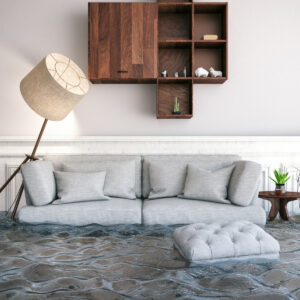
At Reynolds Restoration Services, we understand the emotional turmoil that comes with seeing your cherished belongings immersed in water. As a privately owned business with over 18 years of experience, we’ve helped countless families restore their homes and salvage their possessions after a flood. We believe that prompt action and professional assistance can save and restore many furniture items to their former glory.
The first few hours after a flood are crucial for furniture restoration. The longer your furniture sits in water, the more damage it will sustain. That’s why our team stands ready 24/7 to provide emergency services.
But before help arrives, there are a few things you can do to mitigate the damage. Let’s explore these initial steps and how they can make a significant difference in saving your furniture.
What to Do Immediately After a Flood to Reduce Furniture Damage
When a flood strikes, it’s crucial to act quickly to reduce furniture damage. While safety should be your primary concern, once you’ve ensured everyone is safe and the water has receded, you can take steps to salvage your furniture.
- Prioritize Safety: Before you start any cleanup efforts, make sure it’s safe to do so. Check for structural damage to your home, and watch out for hazards like downed power lines or contaminated floodwater. Wear protective gear, including rubber gloves and boots, to protect yourself from possible contamination.
- Document the Damage: Before you move anything, take photos or videos of all damaged items for insurance purposes. This will provide a record of the extent of the damage and help validate your insurance claims.
- Remove Standing Water: If there’s still water in your home, try to remove as much of it as you can. You can use buckets, towels, mops, or a wet/dry vacuum if it’s safe to use electricity.
- Move Furniture: If it’s safe to do so, move your furniture to a dry area. If some pieces are too heavy or large to move, try placing aluminum foil or wood blocks under the legs to prevent further water absorption.
- Begin Drying Process: Start drying your furniture as soon as possible to prevent mold and mildew growth. Use fans, dehumidifiers, or heaters to speed up the drying process, but keep them away from furniture to prevent fires.
- Clean Your Furniture: Once your furniture is dry, clean it according to the type of material it’s made from. You can clean non-porous materials with a dry cloth, hot water, and a heavy-duty cleaner, while porous materials may need more specialized cleaning solutions.
Remember, the sooner you can start this process, the better the chances of saving your furniture. However, dealing with flood damage can be overwhelming, and sometimes professional help is needed.
At Reynolds Restoration Services, our expert team is ready to step in at a moment’s notice to assist with post-flood cleanup and restoration. We have the tools and knowledge necessary to help save your possessions and bring normalcy back to your life.
What Furniture to Save or Toss After a Flood
After a flood, it can be overwhelming to sift through your belongings and determine what to throw out and what to save. Understanding how to evaluate your furniture for salvageability is crucial in these moments. Here are some guidelines on what furniture to throw out after a flood and what you may be able to save.
What to Throw Out After a Flood
Floodwaters often carry contaminants that pose serious health risks, making many items unsalvageable. When it comes to furniture, pieces made from particleboard, mattresses, box springs, pillows, padding, and furniture coverings should generally be discarded. These items absorb water quickly and are challenging to thoroughly clean and dry.
Upholstered furniture behaves much like a sponge, absorbing large amounts of water, as well as any contaminants present in the floodwater. Unless these items are antiques or particularly valuable, they should typically be thrown away.
Items affected by black water, which is highly contaminated water containing sewage and other toxic materials, should always be discarded. This type of water can cause severe illness if ingested or not properly cleaned up. Any furniture, including solid wood pieces, affected by black water should be considered a total loss due to the high risk of contamination.
What to Save After a Flood
After a flood, people can salvage some furniture, but they will need to discard many items. You can usually restore solid wood furniture, for example, unless the water damage is severe. These pieces will need to be cleaned, dried, and possibly re-glued or refinished.
You can often clean and disinfect metal and plastic furniture fairly easily, but make sure to thoroughly dry these items to prevent rust and further damage.
Remember, when deciding what to throw out after a flood, safety should be your top priority. Always wear protective gear when handling flood-damaged items, especially those affected by black water. If you’re unsure about an item, consider seeking professional help.
How to Restore Water-Damaged Furniture after a Flood
Knowing how to salvage furniture after a flood can save you the heartache of losing cherished items and the expense of replacement. The process varies depending on the type of furniture, but in all cases, quick action is key. Here’s some general advice on how to restore wood, upholstered, and leather furniture after a flood.
Wood Furniture
Solid wood furniture can be particularly susceptible to water damage. Swelling, warping, and discoloration are all potential outcomes of prolonged water exposure. To begin the restoration, first remove any drawers or doors to allow the wooden furniture piece to dry out thoroughly.
Use fans or dehumidifiers to speed up the drying process but avoid placing these devices too close to the furniture as rapid drying can cause cracking. Once the wooden furniture is completely dry, you may need to refinish it to restore its original appearance.
Upholstered Furniture
Upholstered furniture poses unique challenges when it comes to flood restoration. Water can easily seep into the padding and frame, creating a perfect environment for mold and mildew. If the piece is worth saving, start by removing and cleaning all removable parts, such as cushion covers and pillows. These can usually be machine washed on a gentle cycle.
The rest of the piece should be dried as quickly as possible using fans or a wet/dry vacuum. Once dry, use a fabric cleaner to clean the upholstery, following the manufacturer’s instructions.
Leather Furniture
Water-logged leather furniture requires special care after a flood. Start by blotting away as much water as possible with a soft cloth. Avoid rubbing as this can push water further into the leather. Next, use a mild soap or specially formulated leather cleaner to clean the surface.
Once clean, allow the piece to air dry away from direct sunlight or heat sources, which can cause the leather furniture to crack. After the piece is dry, apply a leather conditioner to restore moisture and prevent cracking.
While these tips on how to salvage flood-damaged furniture can help you get started with the restoration process, remember professional help may be required to properly restore your leather furniture.
Flood Damage Emergency Restoration Company in PA and MD
If you had a flood and don’t know what to do, remember you don’t have to deal with it by yourself. At Reynolds Restoration Services, we stand ready to assist you with our prompt, professional, and exceptional emergency restoration services in Pennsylvania and Maryland.
As an independently owned company that’s just celebrated 18 years in the business, we bring a wealth of experience and a commitment to quality to every job. Don’t hesitate to reach out to us on our 24/7 emergency line for a quick response to clean up after a flood. When disaster strikes, trust Reynolds Restoration Services to help you reclaim your space and restore peace of mind.
Let us get your home back to its pre-loss condition and take the stress of a flood off of your shoulders. Call 888.277.8280 for help! Our goal is to Respond and Rebuild with Care!

President of Reynolds Restoration Services. Over 20 years of experience in the emergency restoration industry.

